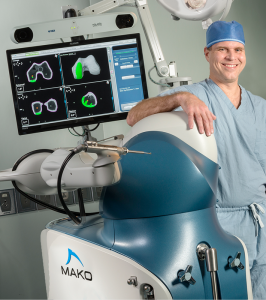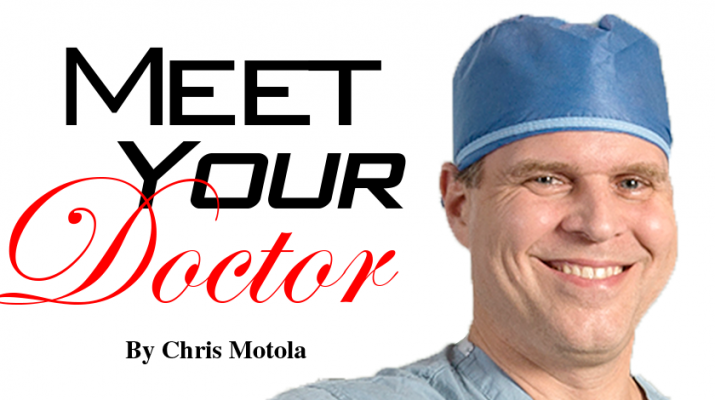Upstate orthopedist talks about same-day total knee replacement
By Chris Motola
 Q: You’re offering same-day knee replacement surgery. How does that work?
Q: You’re offering same-day knee replacement surgery. How does that work?
A: That’s correct. They come in in the morning. They have their knee replacement. And they have their recovery and physical therapy before they go home. They’re instructed in how to walk and do stairs. And once they meet all the discharge criteria, they’re able to be discharged that same afternoon.
Q: What’s changed that’s allowed you to do it this quickly?
A: The key thing that opened the floodgates was that the Centers for Medicare and Medicaid Services reclassified total knees on their list of outpatient surgeries. So there are a number of outpatient surgery centers across the country that are doing these. They have demonstrated that they can be done safely. The key thing is doing it smartly and having a team and pathway organized for the patient to get the best care despite the fact that they’re going home the same day. It’s not the conventional way to do it; I’ve seen it change over the course of my career from the patient arriving the day before surgery, to arriving the same day and then going home a day or two later. Now this is just sort of the next step.
Q: So this is mostly a process-based change, not any kind of technological breakthrough.
A: You are correct. There is not a bit of new technology that is driving this process. It’s the same techniques, procedure and equipment.
Q: How have the outcomes been?
A: We’re at the very early end of the curve. The patients we’ve worked on so far have done well. We’re being very selective at the moment. We are trying to select healthy patients with good support from family members and who are highly motivated. We certainly don’t push this on patients. We want them to be engaged and do well with this program.
Q: Are these mostly younger patients?
A: It’s more the health status. Younger patients, while they might be healthier, aren’t always the best candidates for this. It really just depends upon the individual. But health comorbidities are very important. So we want patients who are good candidates for the operating room, who don’t have medical issues that might arise early after the discharge, like patients with diabetes, kidney failure patients, patients with cardiac disease. It’s not that those patients can’t be done this way, and there are places successfully using more liberal criteria, but we’re being selective about it.
Q: Walk me through the day of one of these patients.
A: So the patient arrives — usually these are first-case-of-the-day patients — between 6 and 6:30 for a 7:30 start case. And they are brought into the pre-operating area by the nursing staff. They get intravenous access, checked in, and all their paperwork is reviewed. Then they’re seen by anesthesia, who discusses what they’re going to do. In terms of anesthesia, we do a few things differently. We use a shorter-acting spinal so that the patient can recover more quickly. In addition, the anesthesiologist will typically discuss the use of a regional block. It’s a different, supplemental means of pain control that’s more localized and longer acting. Those injections will last at least into the next day. So then, after anesthesia talks to them, then the surgeon will see the patient, answer any questions, make sure all the paperwork is in order. Then the family is sent to the waiting area. Also this happens before 7:30. Then the patient will receive the regional block. Then the patient is taken back to the operating room for the 7:30 start. At that point we perform the surgery. Then we put the dressings on, and what’s different here is we bypass the recovery room. The patients are returned to the pre-op area and are cared for by the same nurses who saw them when they came in. At that point, once the spinal starts to wear off, they’re seen by physical therapy. And once the patient’s motor ability returns, they’ll take a few steps with a walker. Once they’re doing well, there’s a platform with a few steps that the physical therapist will work with them on. Once they’ve completed physical therapy and met all the discharge criteria, they’re ready to go home. I, of course, will have been stopping by to check on them multiple times over the course of their recovery. We try to follow up with them the next day and make sure they’re still doing well.
Q: What’s the recovery time?
A: It’s not all that different than the traditional approach. There are no restrictions with regard to weight-bearing or walking right away. As soon as they can progress off the walker, they can do so. We’re still using in-home therapy to help them achieve independence. Some patients do within a couple weeks. Others take longer. Most patients are pretty fully recovered by six to eight weeks.
Lifelines
Name: Timothy A. Damron, M.D.
Position: Professor of orthopedic surgery and vice chairman of orthopedic surgery at Upstate. Also teaches cell and developmental biology and neuroscience and physiology
Hometown: Kewanee, Ill.
Education: MD: University of Illinois College of Medicine, 1988; residency: University of Wisconsin Hospitals and Clinics, 1993; fellowship: Mayo Clinic, 1994
Affiliations: University Hospital; Community General campus; Crouse
Organizations: American Academy of Orthopedic Surgeons; Orthopedic Research Society; Musculoskeletal Tumor Society
Family: Wife (Linda); son (Neil), daughter (Lucia)
Hobbies: Kayaking, hiking, walking with dog.

